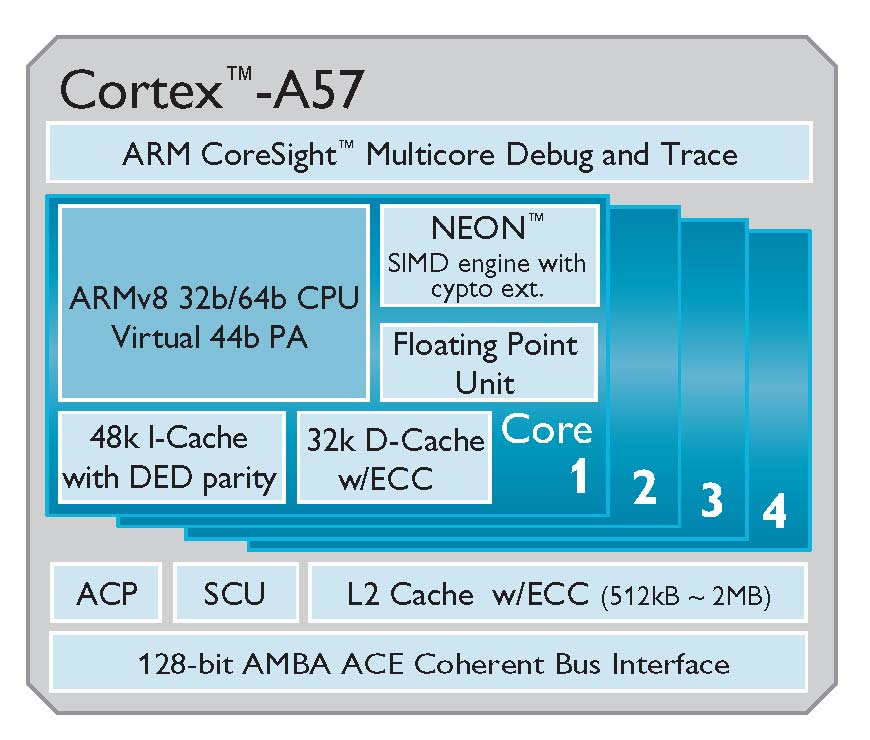ARM, TSMC Tape-out 16nm Cortex-A57 Processor
On Tuesday ARM and TSMC announced that they have successfully completed the first tape-out of a 64-bit ARM Cortex-A57 processor on 16-nm FinFET process technology. Yes, your tablet and smartphone just became even more obsolete.
According to the British mobile chip designer, it took six months for both parties to jointly move from RTL to tape-out. They used ARM's Artisan physical IP, TSMC memory macros, and EDA technologies enabled by TSMC's Open Innovation Platform (OIP) design ecosystem. ARM said this is its highest performing processor yet, ideal for compute intensive applications such as high-end computer, tablet and server products.
The tape-out is the first milestone in their collaboration to jointly optimize the 64-bit ARMv8 processor series on TSMC FinFET process technologies. It follows their previous collaboration in the 64-bit arena with the 20-nm FinFET process technology that began back in 2012.
"This first ARM Cortex-A57 processor implementation paves the way for our mutual customers to leverage the performance and power efficiency of 16nm FinFET technology," said Tom Cronk, executive vice president and general manager, Processor Division, ARM.
The new Cortex-A57 is now ready for mass production, and promises three times the CPU power of current chips like Samsung's Exynos 5, but with the same battery life. It can be be implemented individually, or paired with the Cortex-A53 processor into an ARM big.LITTLE configuration that enables scalable performance and optimal energy-efficiency.
"The joint effort of ARM, TSMC, and TSMC's OIP design ecosystem partners demonstrates the strong commitment to provide industry-leading technology for customer designs to benefit from our latest 64-bit ARMv8 architecture, big.LITTLE processing and ARM POP IP across a wide variety of market segments," Cronk added.
ARM said early adopters can now implement the new 16-nm Corterx-A57 chip into their designs. We'll likely see resulting devices in the latter half of 2013.
Get Tom's Hardware's best news and in-depth reviews, straight to your inbox.

Kevin Parrish has over a decade of experience as a writer, editor, and product tester. His work focused on computer hardware, networking equipment, smartphones, tablets, gaming consoles, and other internet-connected devices. His work has appeared in Tom's Hardware, Tom's Guide, Maximum PC, Digital Trends, Android Authority, How-To Geek, Lifewire, and others.
-
chicofehr Does this mean 16nm GPU soon? my 7950 is struggling with all the 8K textures and 30" monitor on Skyrim :PReply -
axarm This is tapeout. That is a design on paper not silicon. Arm will not have full productions of their A15 finfet till sometime in 2014 at the earliest. The A57 will NOT be produced before the A15. So full production is at least 2 years if not 3 years off.Reply -
hero1 If only they could jump from 28nm GPU chips to this and increase performance and efficiency. I would like to see the benchmarks for this. Intel has got to get going and bring something to the game fast if they are to take a chunk out of ARM shares in mobile sector.Reply -
axarm Intel will be going to 22nm finfet this fall from 32nm nonfinfet now. Look at the 32nm Lenovo K900 benchmarks and they faster than the Samsung S4.With the move to 22nm finfet and other changes, Intel's Baytrail will have twice the performance. Arm will never have the performance or efficiency lead in mobile SoC again (that includes servers).Reply -
tmk221 axarm Arm will never have the performance or efficiency lead in mobile SoC again (that includes servers).Reply
Let's see Intel taking the lead in efficiency area first. Then we can discuss whether ARM will be able to catch up again or not... -
g00fysmiley looking forward to the increased processing power and efficiency, but still screens burn the most power, need mroe efficiency there to but still looking forward to benchmarks and seeing if the claimed performance increases will be as much as claimedReply -
-Fran- Charlie said something about "read between the lines and cut the BS".Reply
There's more info in the Steamroller CPU thread in the forums.
Cheers! -
A Bad Day tmk221Let's see Intel taking the lead in efficiency area first. Then we can discuss whether ARM will be able to catch up again or not...Reply
They already do, according to Anandtech: http://www.anandtech.com/show/6529/busting-the-x86-power-myth-indepth-clover-trail-power-analysis
Now the question is, can Intel get manufacturers interested to switch from ARM? -
Bricktop If I had to guess, A57 devices will hit the market in mid-to-late 2014 at the earliest. TSMC hasn't announced that the 16nm FinFet fab is production ready yet. Once that happens, Nvidia and Qualcomm have to get some samples and determine how to implement/modify these cores into their SoC design. Additionally, while the A57 will be produced using the 16nm Fab, the the transistors on the chip will be 20nm according to Engadget.Reply
By the time these chips make it to the consumer, Intel will have already pushed out 14nm products. Judging by the fact that Intel is opening up it's Fab to outside businesses (possibly even Apple), I would assume they will have additional production space to create 14nm SoC's soon after the release of "Broadwell". Intel just got it's feet wet in the smartphone space, but I think it will be a heated battle; Intel vs ARM by 2015. -
InvalidError axarmThis is tapeout. That is a design on paper not silicon.Tape-out is one of the last steps before before lithography masks are made and first silicon can be produced. Depending on how much of a hurry ARM and TSMC are to have their first test silicon out, they could have their first (potentially) working chips in 3-4 months. The likelihood of nailing it on the first spin is low but it can happen... but even if they do, they will likely need a few more months to tune yields.Reply
If there aren't any major setbacks, it could turn up in consumer devices in late 2014.
